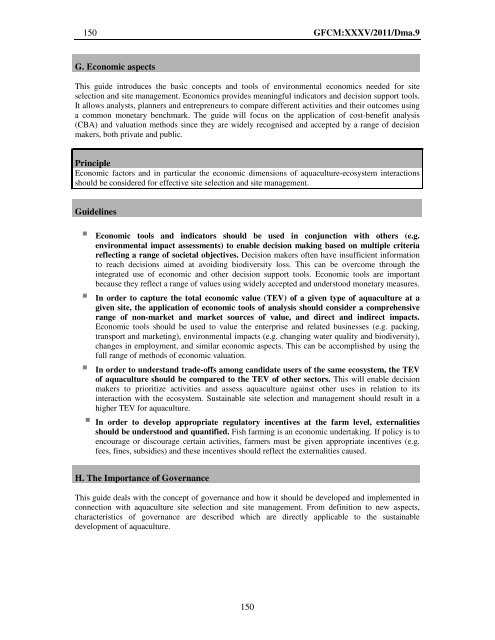Site selection and carrying capacity in Mediterranean ... - FAO Sipam
Site selection and carrying capacity in Mediterranean ... - FAO Sipam
Site selection and carrying capacity in Mediterranean ... - FAO Sipam
Create successful ePaper yourself
Turn your PDF publications into a flip-book with our unique Google optimized e-Paper software.
150 GFCM:XXXV/2011/Dma.9<br />
G. Economic aspects<br />
This guide <strong>in</strong>troduces the basic concepts <strong>and</strong> tools of environmental economics needed for site<br />
<strong>selection</strong> <strong>and</strong> site management. Economics provides mean<strong>in</strong>gful <strong>in</strong>dicators <strong>and</strong> decision support tools.<br />
It allows analysts, planners <strong>and</strong> entrepreneurs to compare different activities <strong>and</strong> their outcomes us<strong>in</strong>g<br />
a common monetary benchmark. The guide will focus on the application of cost-benefit analysis<br />
(CBA) <strong>and</strong> valuation methods s<strong>in</strong>ce they are widely recognised <strong>and</strong> accepted by a range of decision<br />
makers, both private <strong>and</strong> public.<br />
Pr<strong>in</strong>ciple<br />
Economic factors <strong>and</strong> <strong>in</strong> particular the economic dimensions of aquaculture-ecosystem <strong>in</strong>teractions<br />
should be considered for effective site <strong>selection</strong> <strong>and</strong> site management.<br />
Guidel<strong>in</strong>es<br />
Economic tools <strong>and</strong> <strong>in</strong>dicators should be used <strong>in</strong> conjunction with others (e.g.<br />
environmental impact assessments) to enable decision mak<strong>in</strong>g based on multiple criteria<br />
reflect<strong>in</strong>g a range of societal objectives. Decision makers often have <strong>in</strong>sufficient <strong>in</strong>formation<br />
to reach decisions aimed at avoid<strong>in</strong>g biodiversity loss. This can be overcome through the<br />
<strong>in</strong>tegrated use of economic <strong>and</strong> other decision support tools. Economic tools are important<br />
because they reflect a range of values us<strong>in</strong>g widely accepted <strong>and</strong> understood monetary measures.<br />
In order to capture the total economic value (TEV) of a given type of aquaculture at a<br />
given site, the application of economic tools of analysis should consider a comprehensive<br />
range of non-market <strong>and</strong> market sources of value, <strong>and</strong> direct <strong>and</strong> <strong>in</strong>direct impacts.<br />
Economic tools should be used to value the enterprise <strong>and</strong> related bus<strong>in</strong>esses (e.g. pack<strong>in</strong>g,<br />
transport <strong>and</strong> market<strong>in</strong>g), environmental impacts (e.g. chang<strong>in</strong>g water quality <strong>and</strong> biodiversity),<br />
changes <strong>in</strong> employment, <strong>and</strong> similar economic aspects. This can be accomplished by us<strong>in</strong>g the<br />
full range of methods of economic valuation.<br />
In order to underst<strong>and</strong> trade-offs among c<strong>and</strong>idate users of the same ecosystem, the TEV<br />
of aquaculture should be compared to the TEV of other sectors. This will enable decision<br />
makers to prioritize activities <strong>and</strong> assess aquaculture aga<strong>in</strong>st other uses <strong>in</strong> relation to its<br />
<strong>in</strong>teraction with the ecosystem. Susta<strong>in</strong>able site <strong>selection</strong> <strong>and</strong> management should result <strong>in</strong> a<br />
higher TEV for aquaculture.<br />
In order to develop appropriate regulatory <strong>in</strong>centives at the farm level, externalities<br />
should be understood <strong>and</strong> quantified. Fish farm<strong>in</strong>g is an economic undertak<strong>in</strong>g. If policy is to<br />
encourage or discourage certa<strong>in</strong> activities, farmers must be given appropriate <strong>in</strong>centives (e.g.<br />
fees, f<strong>in</strong>es, subsidies) <strong>and</strong> these <strong>in</strong>centives should reflect the externalities caused.<br />
H. The Importance of Governance<br />
This guide deals with the concept of governance <strong>and</strong> how it should be developed <strong>and</strong> implemented <strong>in</strong><br />
connection with aquaculture site <strong>selection</strong> <strong>and</strong> site management. From def<strong>in</strong>ition to new aspects,<br />
characteristics of governance are described which are directly applicable to the susta<strong>in</strong>able<br />
development of aquaculture.<br />
150
















